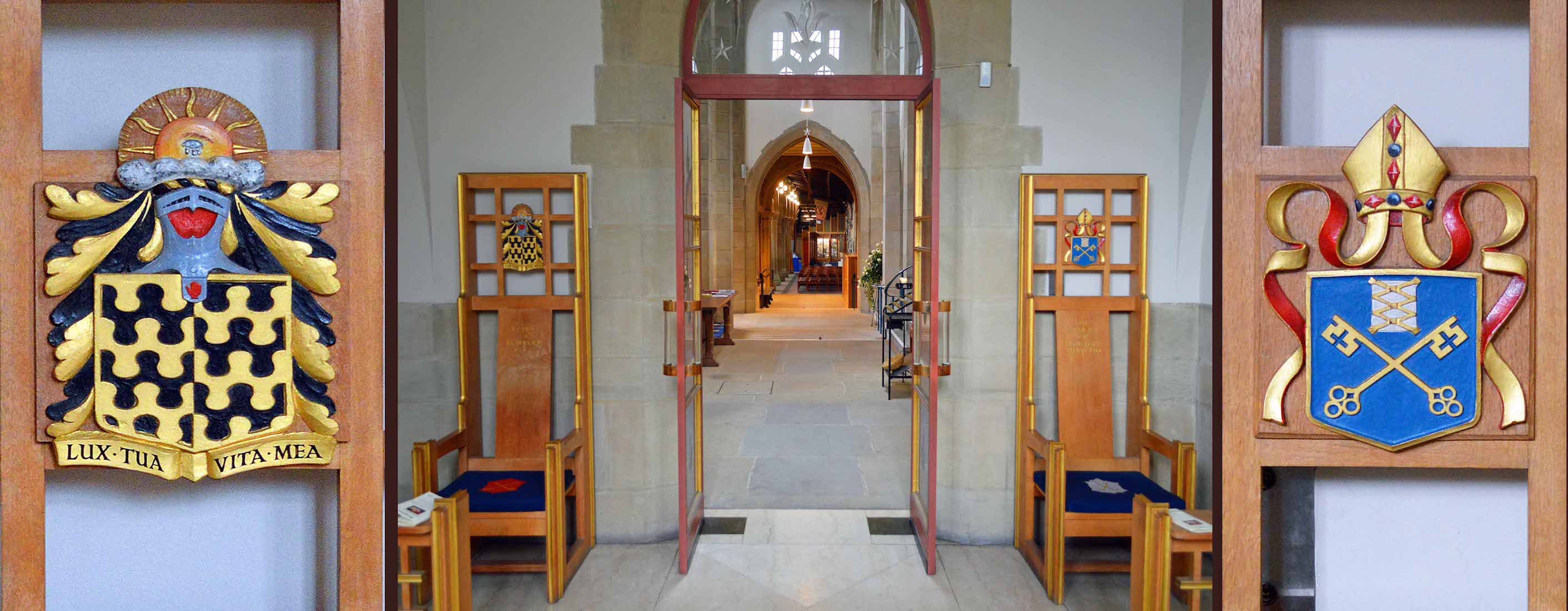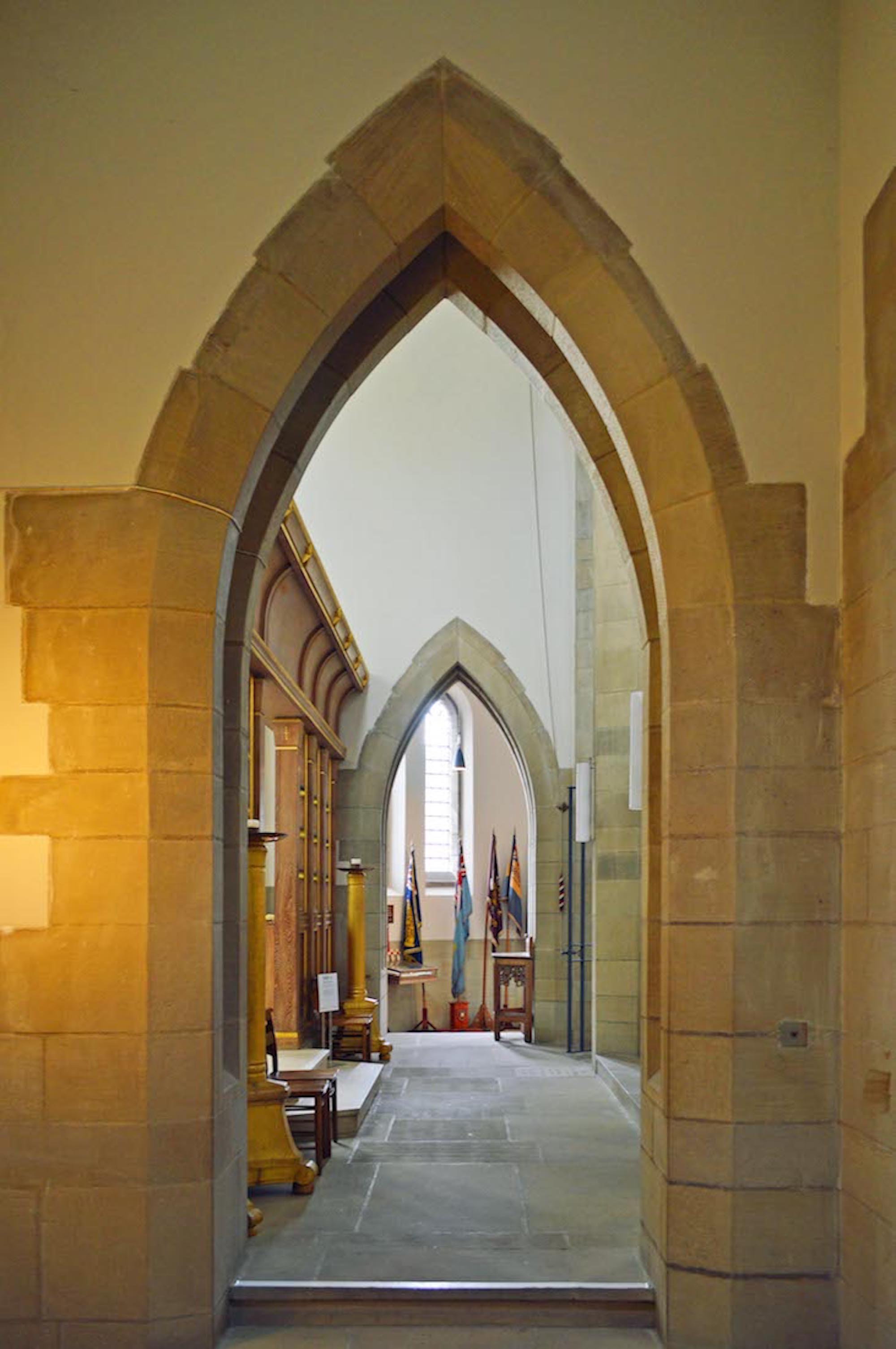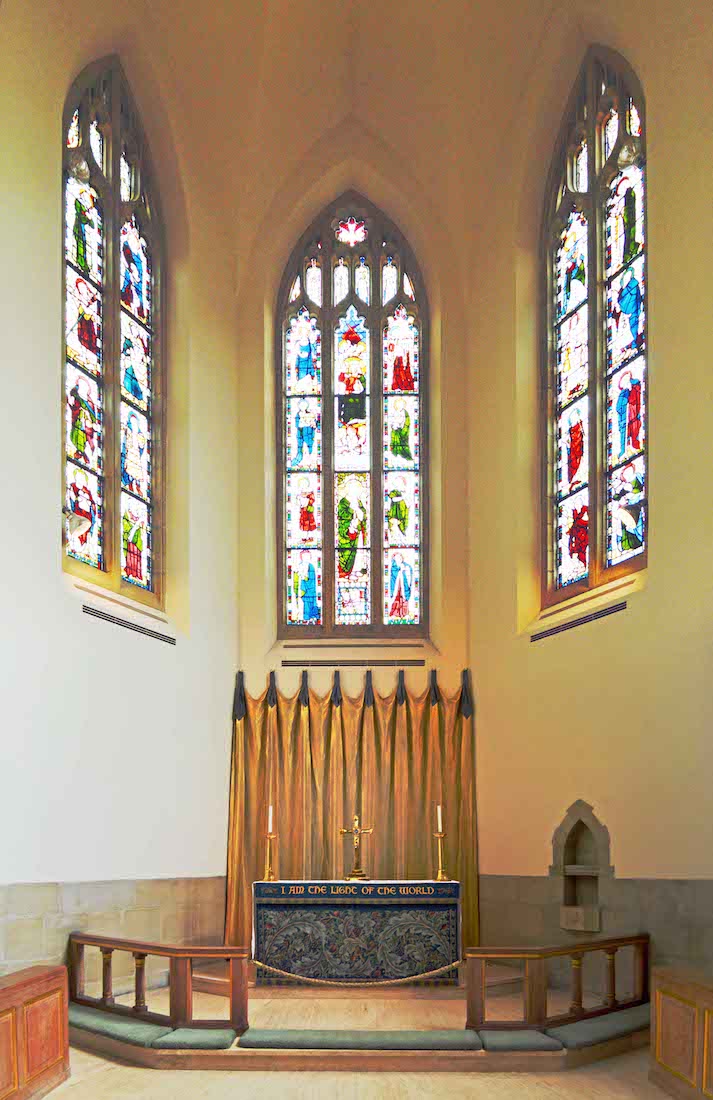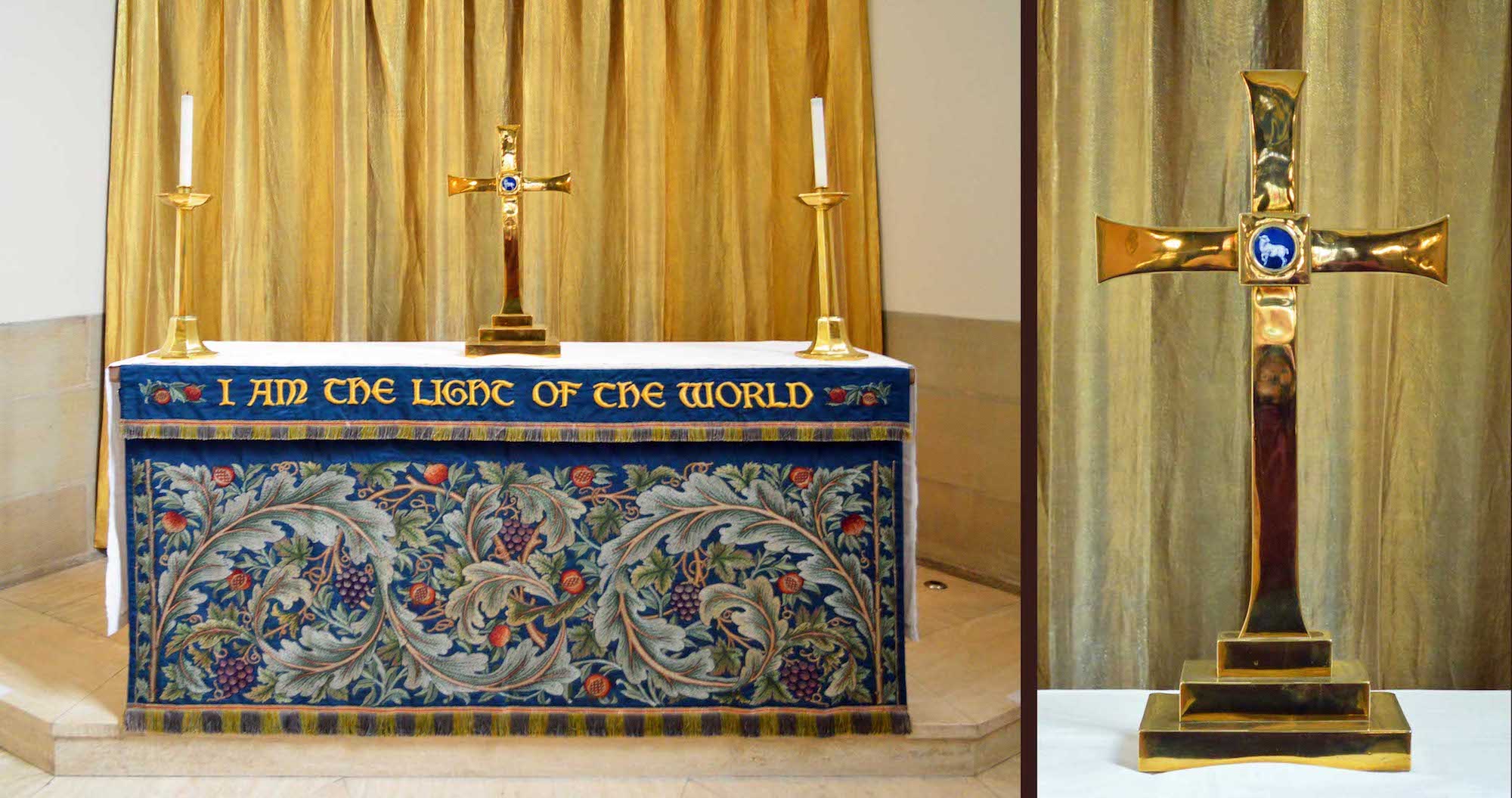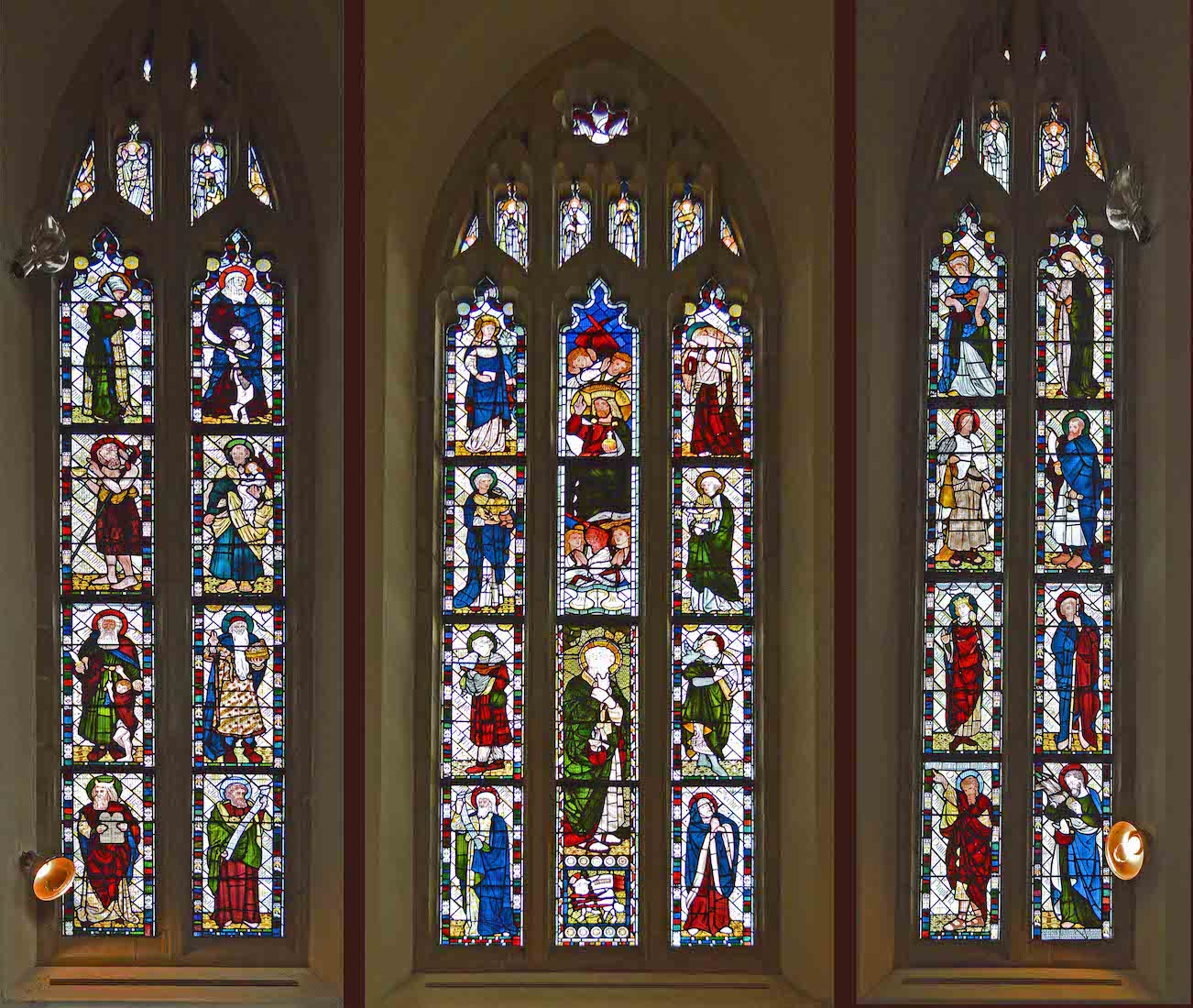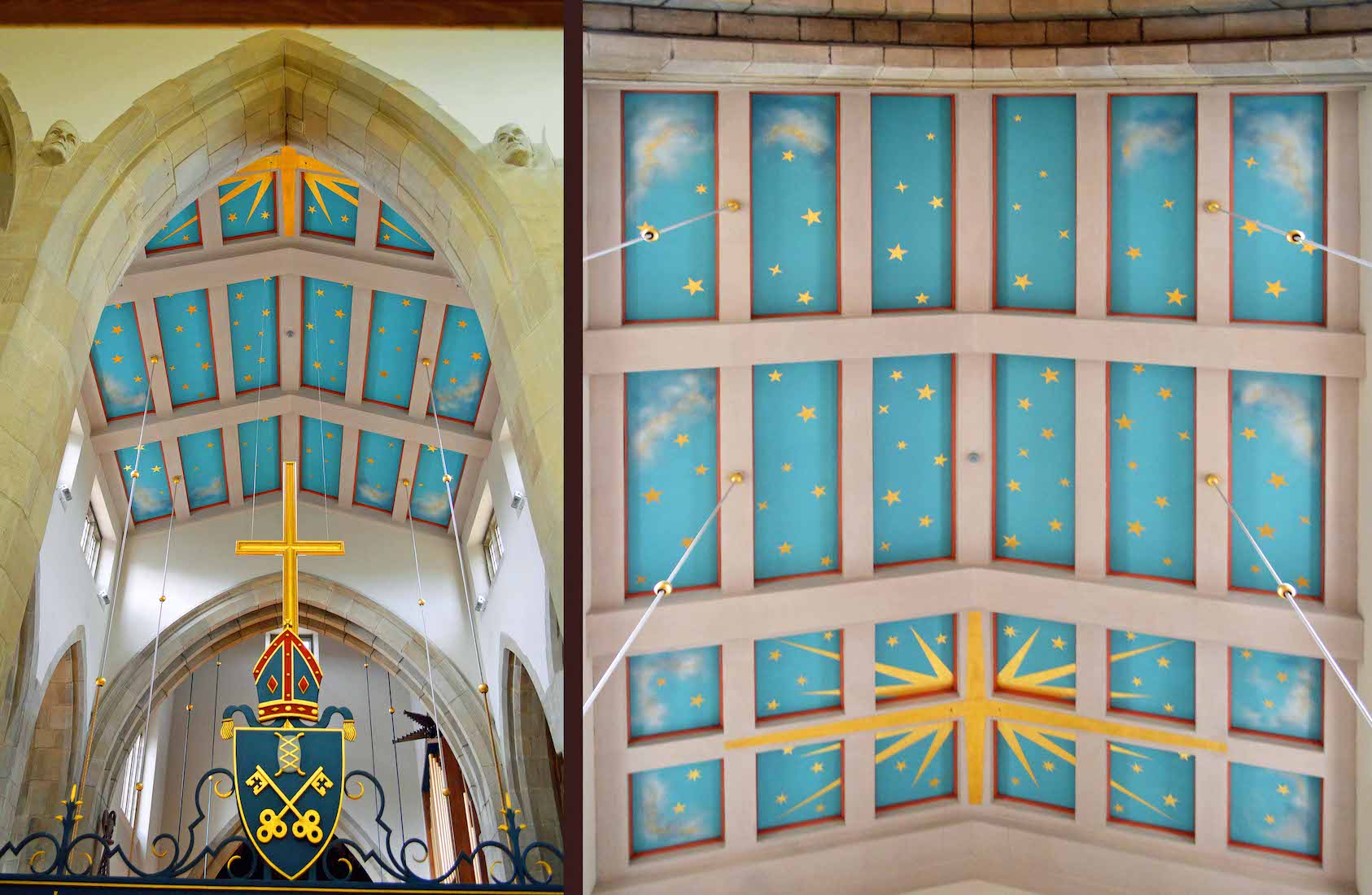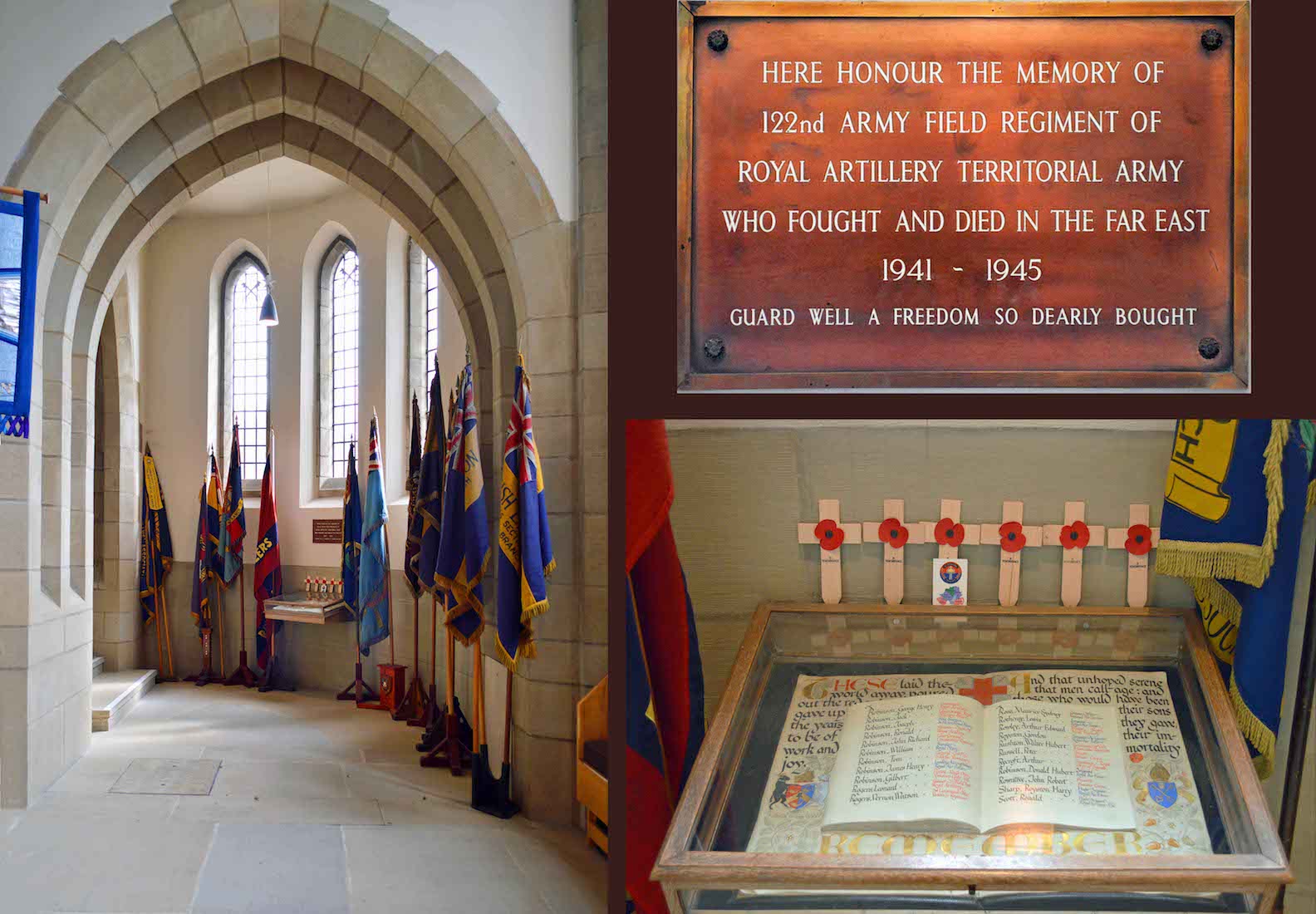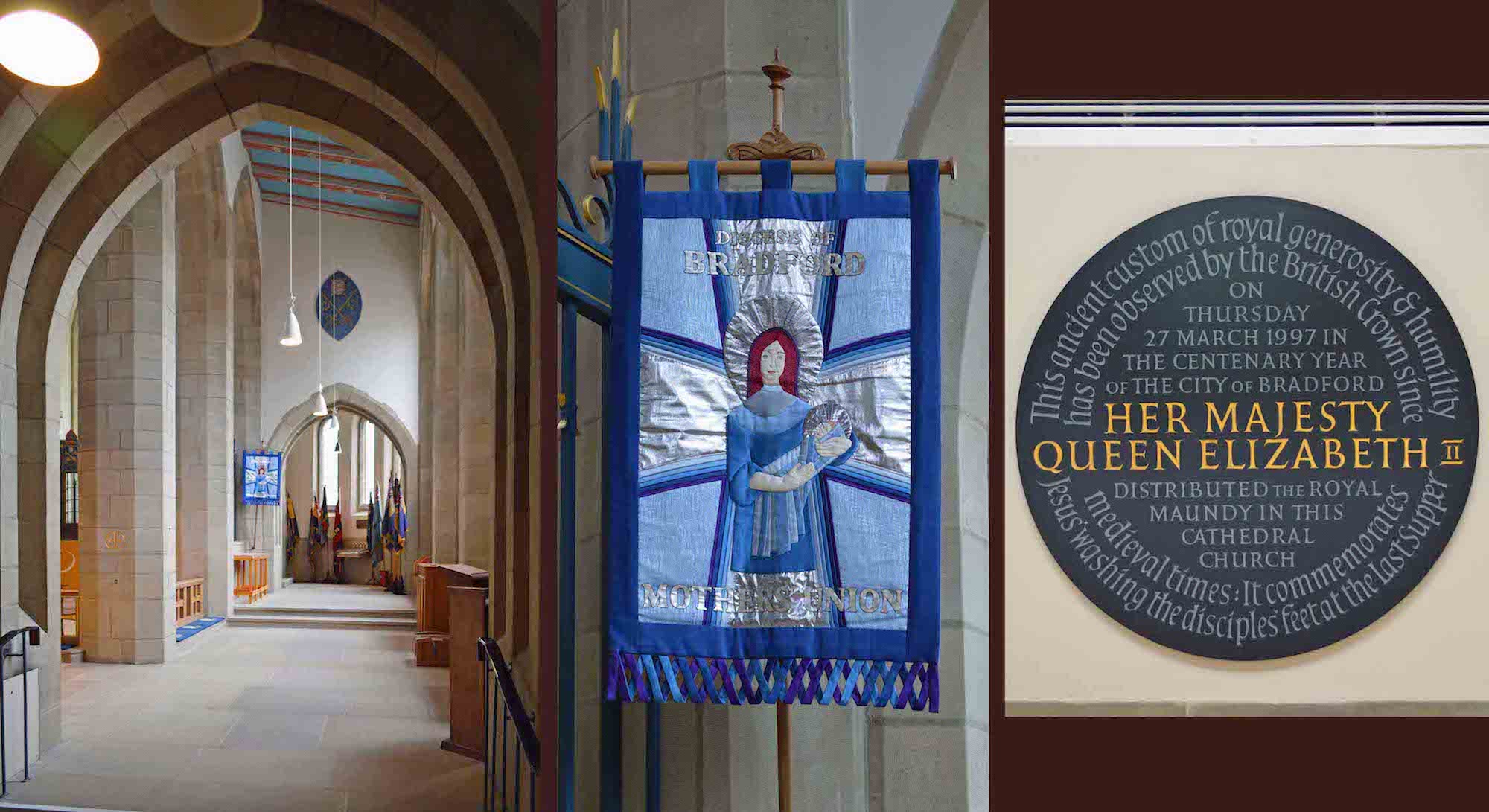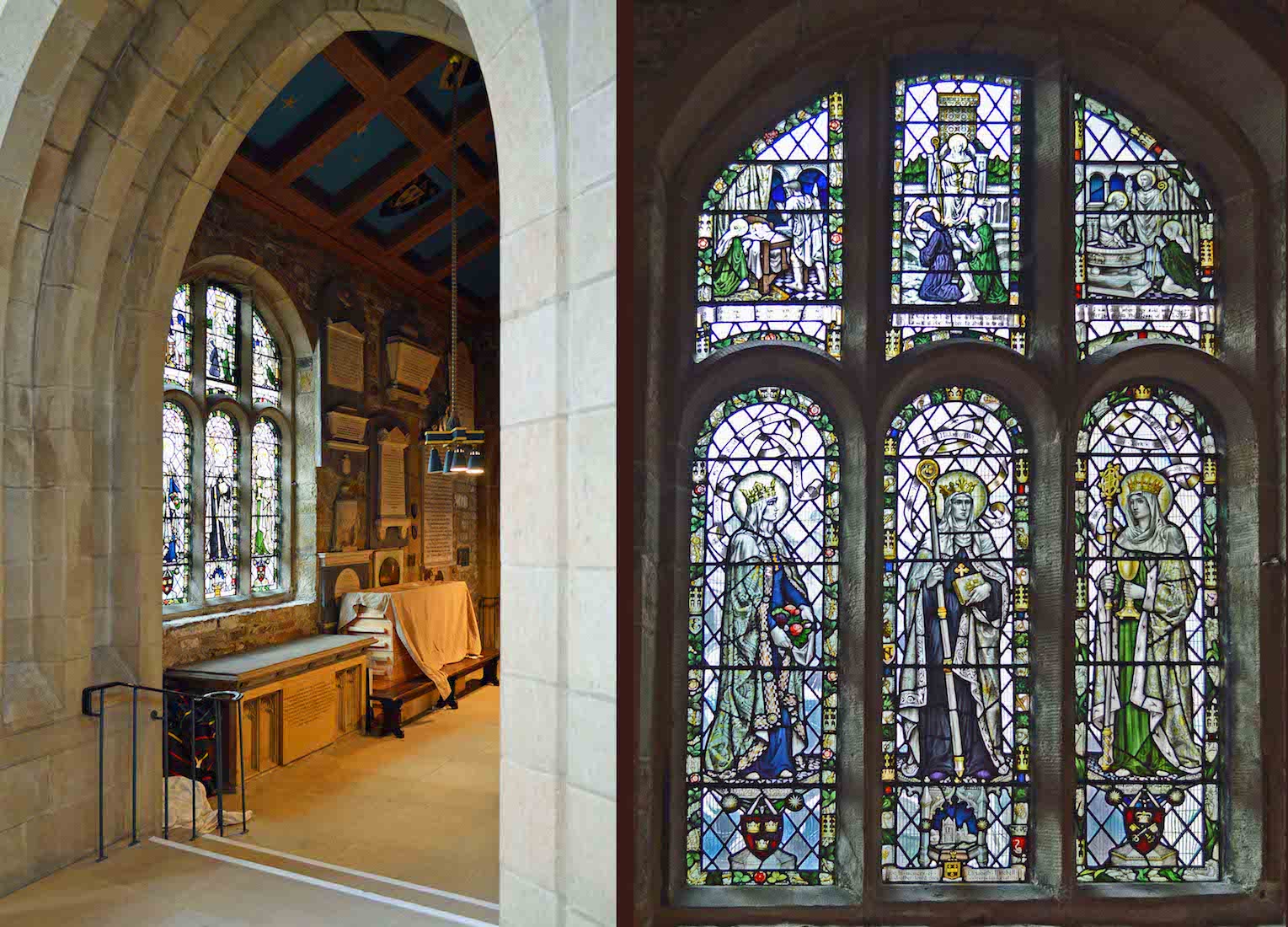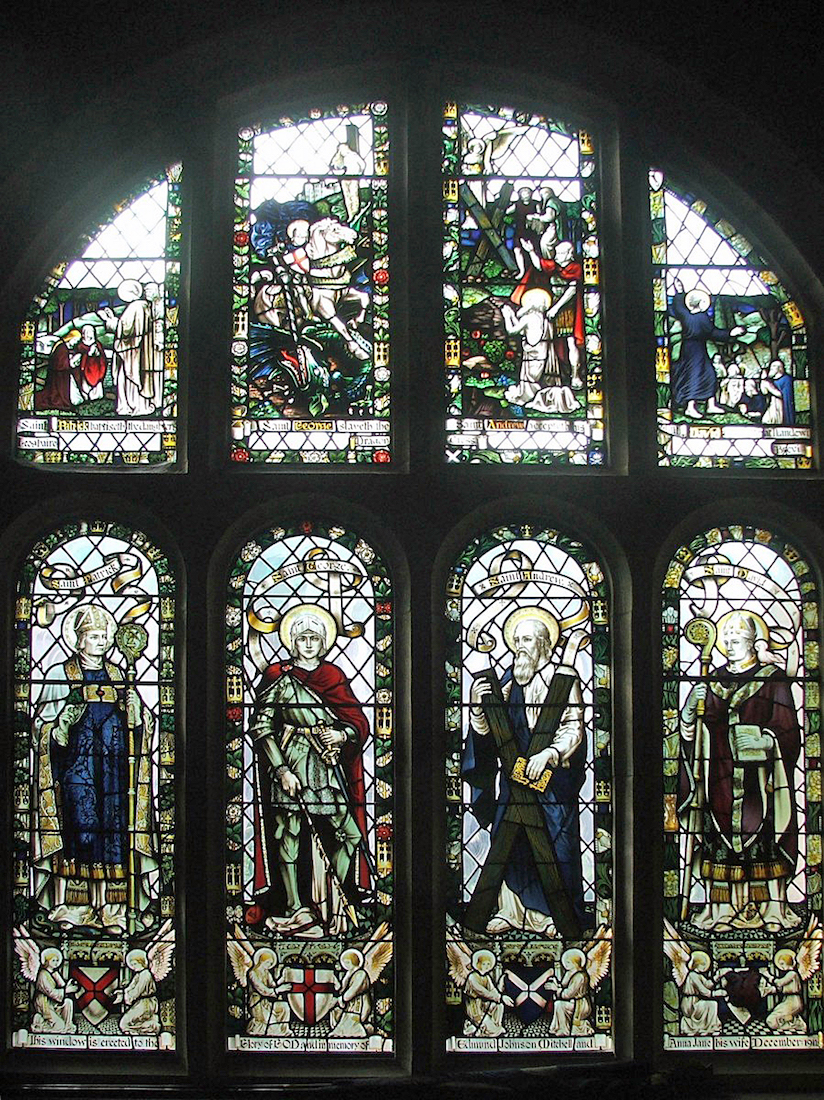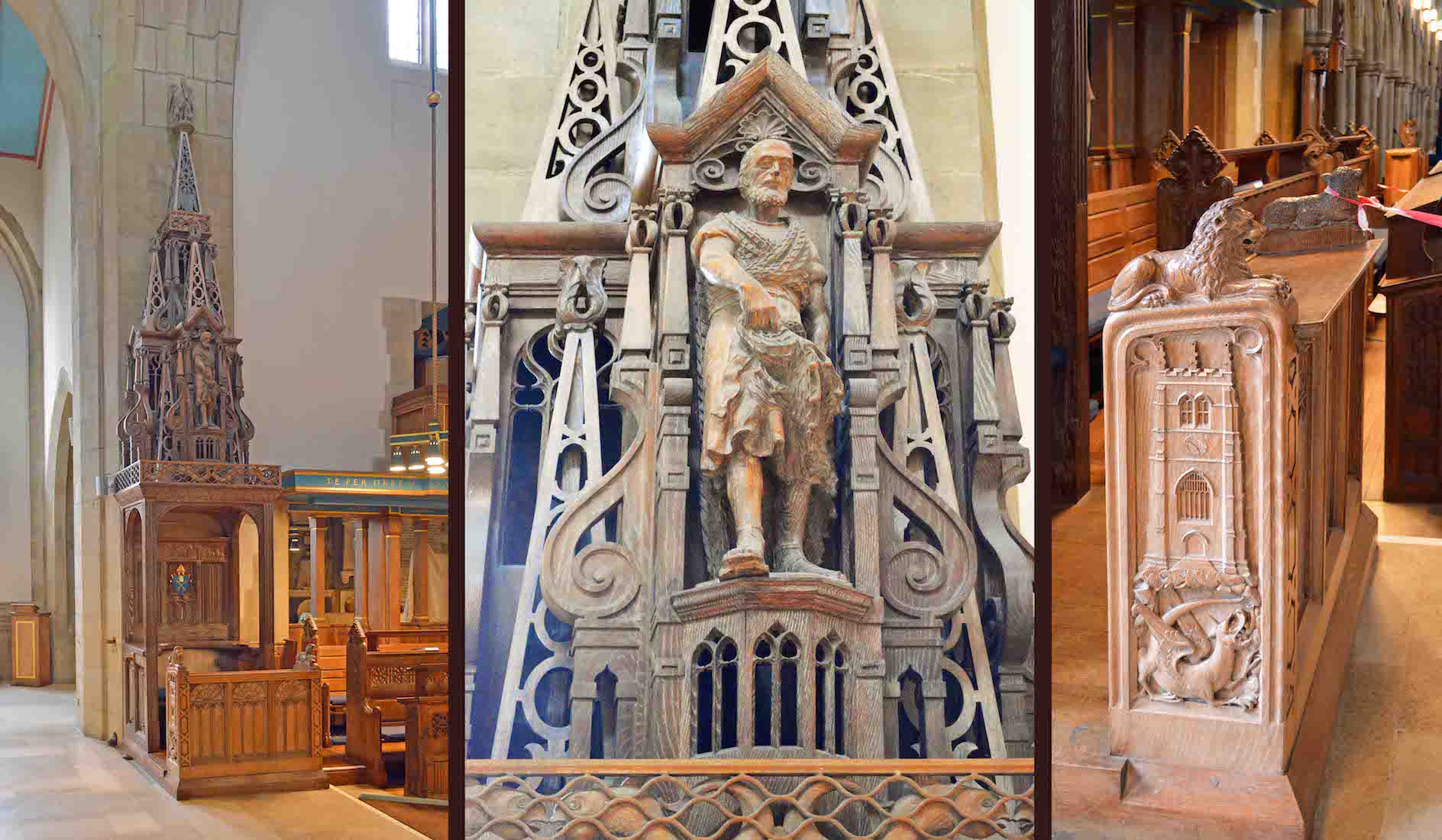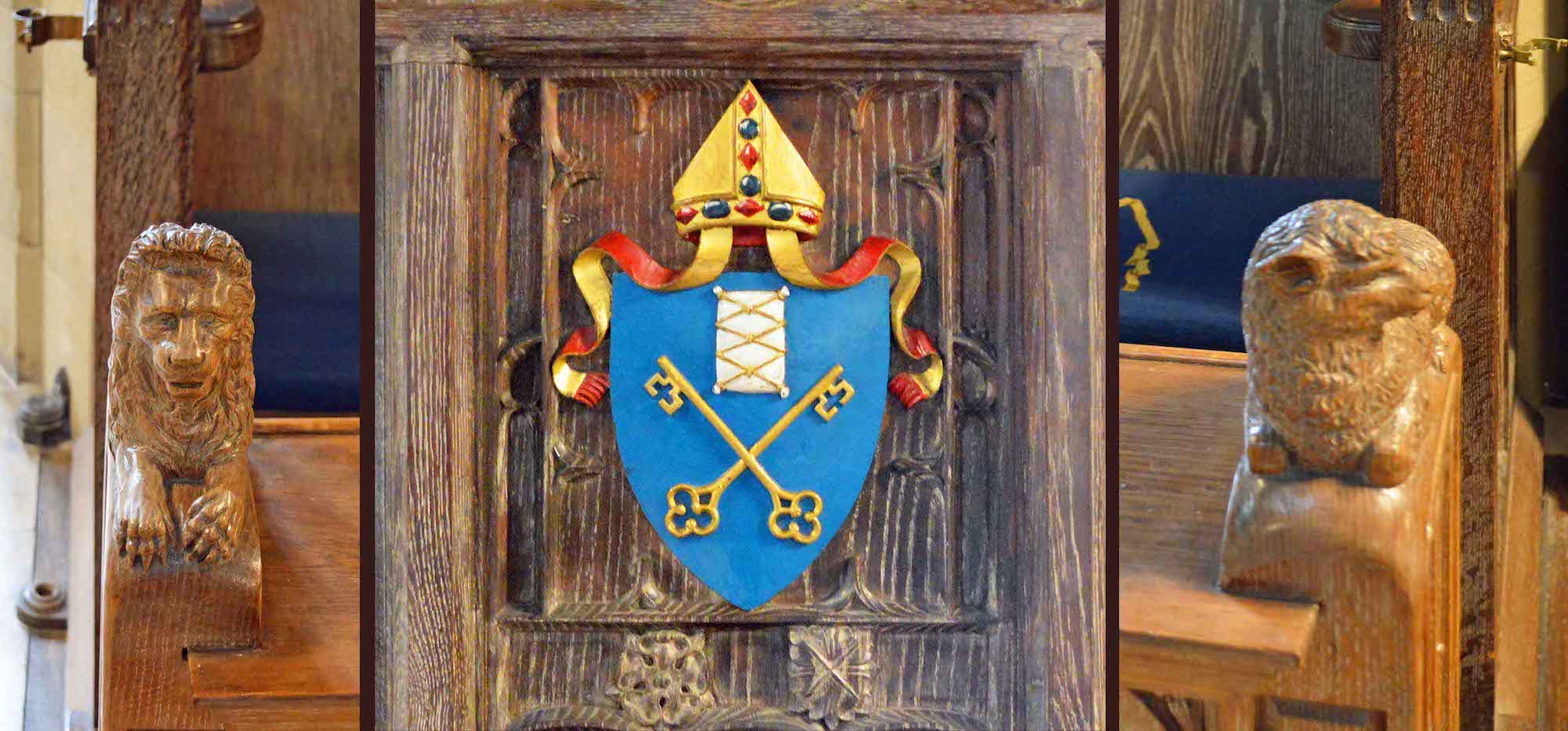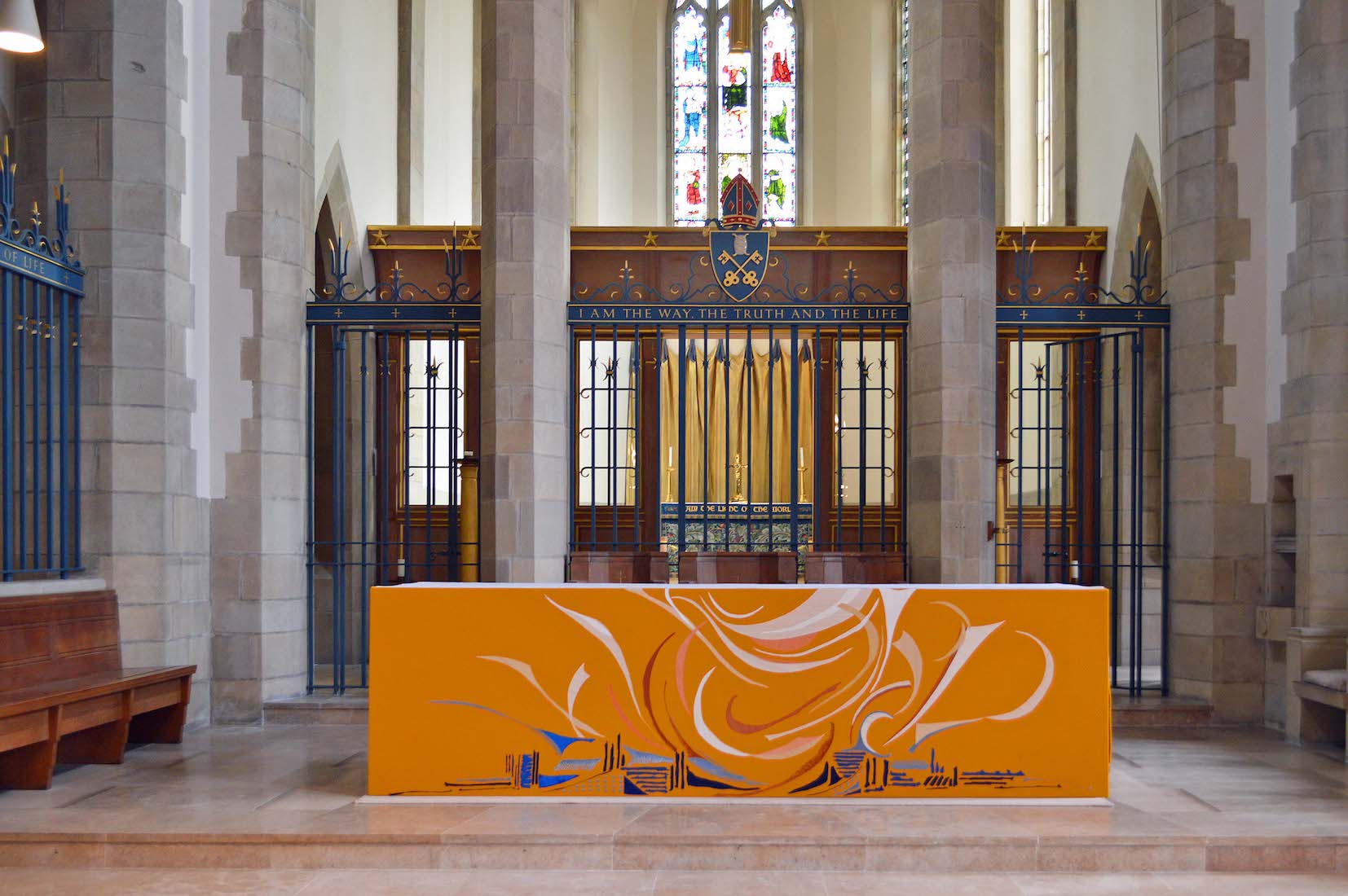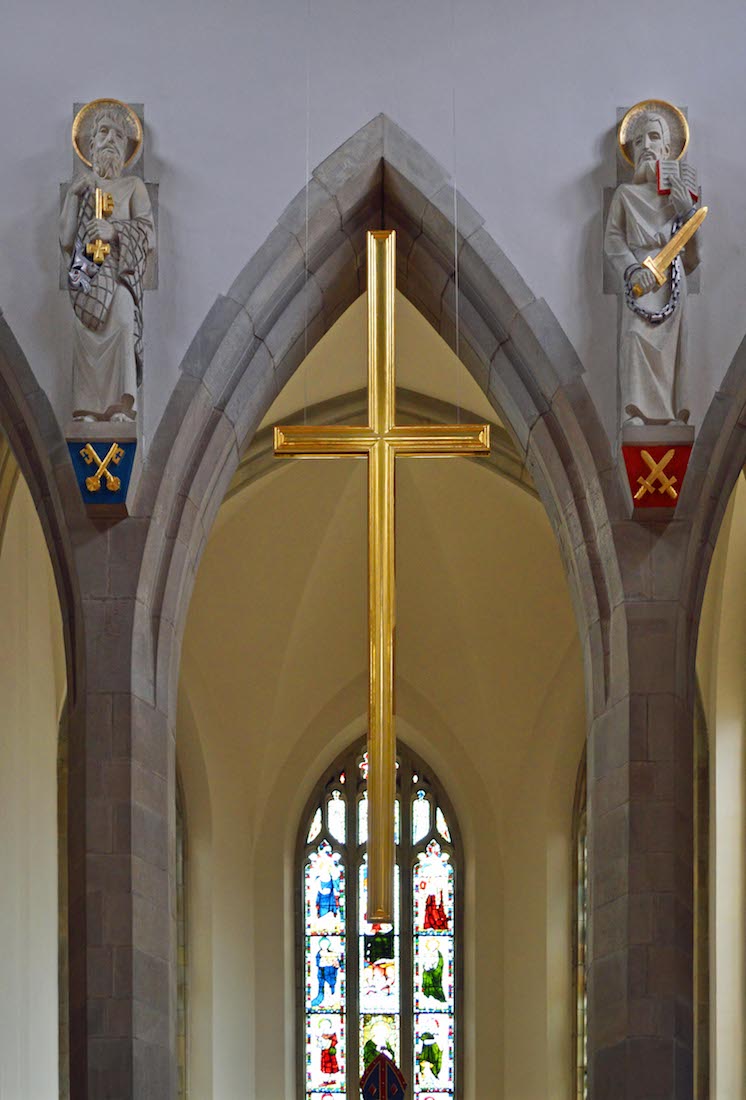61. ENTERING THE CHAPELOF THE HOLY SPIRIT
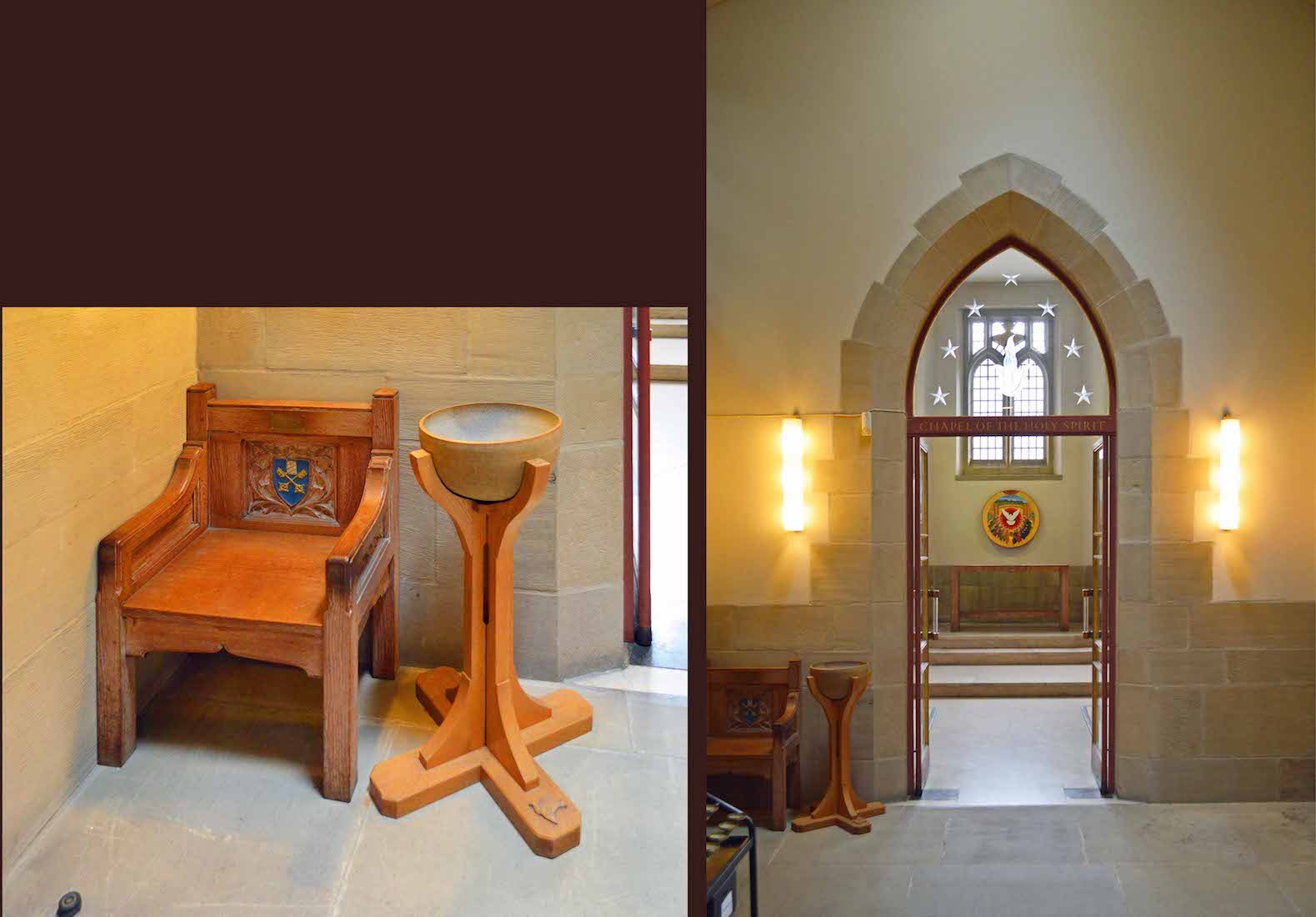
We leave St Aidan’s Chapel and move to the adjacent Holy Spirit Chapel. Outside is a stoup of holy water and a small chair bearing the Bradford Diocese crest of crossed keys and wool-pack. Above the door is the name of the chapel, and an etched glass panel with seven stars and a central flame. PLAN
62. CHAPEL OF THE HOLY SPIRIT
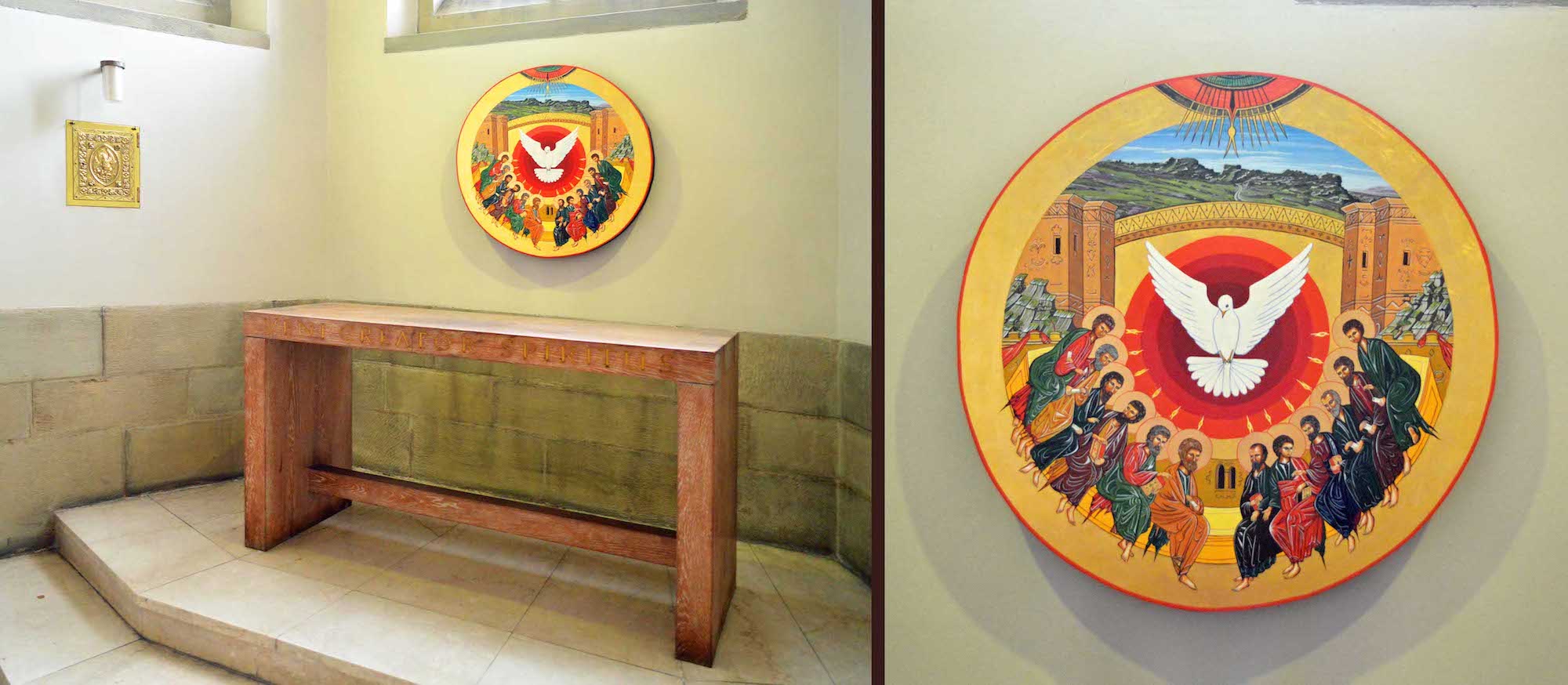
This simple chapel is a place of solitude and reflection. On the wall at left is an aumbry, and above the front table an icon of the Holy Spirit, written by John Coleman in 2008, which shows the apostles at Pentecost. Above the traditional central figure of the dove is the local touch of a depiction of the Cow and Calf rocks on Ilkley Moor – a symbol of the Holy Spirit descending on all of creation.
63. TWO CHAIRS
We turn to leave the Chapel of the Holy Spirit, and find a chair on either side of the doorway. The two chairs were originally for the Archdeacons of Bradford and Craven, and they form a memorial for Bishop Blunt (perhaps best known for his comments just before the abdication of Edward VIII, which are usually acknowledged as starting the proceedings). The Archdeacon’s chair at left bears the arms of the Blunt family. The Archdeacon of Bradford’s chair bears the arms of the Diocese of Bradford. The chairs are now used for those who wish to sit quietly in this chapel, in contemplation or prayer.
64. EAST AMBULATORY
At this point the ambulatory turns South, and progressing forward, the Lady Chapel is on our left.
66. FRONTAL AND CROSS
This altar frontal is interesting because it combines the themes of the grape vine and the pomegranate. The pomegranate is a symbol of the resurrection and the hope of eternal life. Because of its abundance of seeds, it can also symbolize royalty and the church, where the seeds represent the many believers who make up the one universal church. The seeds bursting forth from the pomegranate are also likened to Christ bursting forth from the tomb. The altar cross has a striking blue central image of a lamb – an allusion to the Lamb of God. ••• This altar frontal designed by William Morris had been forgotten about for many years until it was re-discovered in 2005. The Cathedral’s Head Verger from 2005-2018, Jon Howard, recalled that some months after he joined the Cathedral in 2005, he was exploring the linen press in the Sacristy when he came across the altar frontal pushed to the back of one of the large drawers. He asked the Head Verger Emeritus – who had been at the Cathedral for 50 years – about it, but he couldn’t remember ever seeing it before. It was in a poor state so could not be used. The Victoria & Albert Museum confirmed that it was a Morris design, although the original had strawberries rather than the pomegranates seen in this design. The restoration of the Morris altar frontal was eventually triggered by the Cathedral’s wish to restore a World War 1 frontal for the Battle of the Somme centenary commemoration. Jacqui Hyman was commissioned to restore the World War 1 altar frontal and subsequently, the William Morris frontal. ••• Bradford Cathedral has several William Morris connections and it seemed fitting that the restored William Morris altar frontal should be placed in the Lady Chapel, underneath the William Morris and Company windows.
67. CHAPEL WINDOWS
The seven panels shown here were originally part of a seven-arched East window donated in 1863 by Mrs Richard Tolsen in memory of her husband. The limitations at the time of a seven-arched window did not lend itself to a pictorial composition, so the theme of ‘a cloud of witnesses’ was chosen. During the 1960s extension work, this window was removed and re-installed as three separate windows in the new East End. The window contains designs by Philip Webb, Dante Gabriel Rossetti, Edward Burne-Jones, Ford Madox-Brown and Peter Marshall, as well as William Morris himself. ••• The Cathedral contains several early examples of stained glass windows by Morris, Marshall, Faulkner & Co. of London.
68. SANCTUARY ROOF
Returning to the East ambulatory, we can now look back across the altar to the blue and gold sanctuary roof, showing the starry heavens, and ‘the star that shone in the East’. Maufe, the architect for the 1950s and 60s additions, liked and used the ‘Morning Star’ motif in other (east-facing) churches.
69. REGIMENTAL COLOURS
At the South end, the East ambulatory curves around, and here there is a display of British Legion and Regimental Colours. An illuminated Remembrance Book can be found here too, and a memorial plaque which reads: ‘Here honour the memory of 122nd Army Field Regiment of Royal Artillery Territorial Army who fought and died in the far East 1941 – 1945 Guard well a freedom so dearly bought.’
70. SOUTH AMBULATORY
Walking back towards the nave we pass the vivid blue banner of the Diocese of Bradford Mothers’ Union, and also a plaque with the text: ‘On Thursday 27 March 1997 in the Centenary Year of the City of Bradford, Her Majesty Queen Elizabeth II distributed the Royal Maundy in this Cathedral Church.’
71. SOUTH AMBULATORY WINDOW
There is one further ambulatory window, and this is the Mitchell Memorial Window. It was inserted in 1911 or 1912 and is thought to be created by A K Nicholson. It shows three women of faith. From left we have: • Elizabeth of Hungary, 1207 – 1231, who was a princess who became an early Franciscan; • Hilda of Whitby, 614 – 680 who founded a double monastery; and • Ethelburga, 7th Century, a Christian princess of Kent.
72. LISTENING ROOM WINDOW
We take time here to slip around the corner into the former Listening Room – now used as an exit and storage space. This is not generally open to the public, but one can ask nicely! The window here depicts the four patron saints of the British Isles: Patrick, George, Andrew and David.
73. CATHEDRA
The Bishop’s throne or ‘cathedra’ in Latin was given by the people of Ripon Diocese, from which the Bradford Diocese was created in 1919. On the canopy the Cathedral’s patron saint, Peter the fisherman, is shown in a striking representation with his nets and fish. The end of the cathedra bench shows a relief of the Cathedral clock tower, built on a rock which imprisons a dragon. This represents the words of Jesus to Peter: ‘On this rock I will build my church, and the gates of hell shall not prevail against it.’
74. CATHEDRA DETAILS
We also notice the lion and the lamb on the bench of the cathedra, and on the back, once again, the crest of the Bradford Diocese. At the very top of the cathedra (not shown) is a carved pelican, alluding to a legend that the mother pelican feeds its chicks with blood drawn from her breast.
75. ALTAR
We have looked at this altar earlier, but as we come to the end of our tour of Bradford Cathedral, it seems fitting that we should return here. The Cathedral contains many interesting and beautiful things, but it is built to glorify God in the death and Resurrection life of Christ, and that is the focus of the altar.
76. SANCTUARY CROSS
Above the altar is this large Cross of mahogany burnished with gold, accentuating the height of this space. On the wall are statues of St Peter and St Paul carved by a local craftsman Raymond Perkins. In medieval times, this church was dedicated to St Peter and St Paul. St Peter remains the patron saint of this Cathedral and is shown with his fishing net and symbolic key. This completes our tour of this Cathedral.
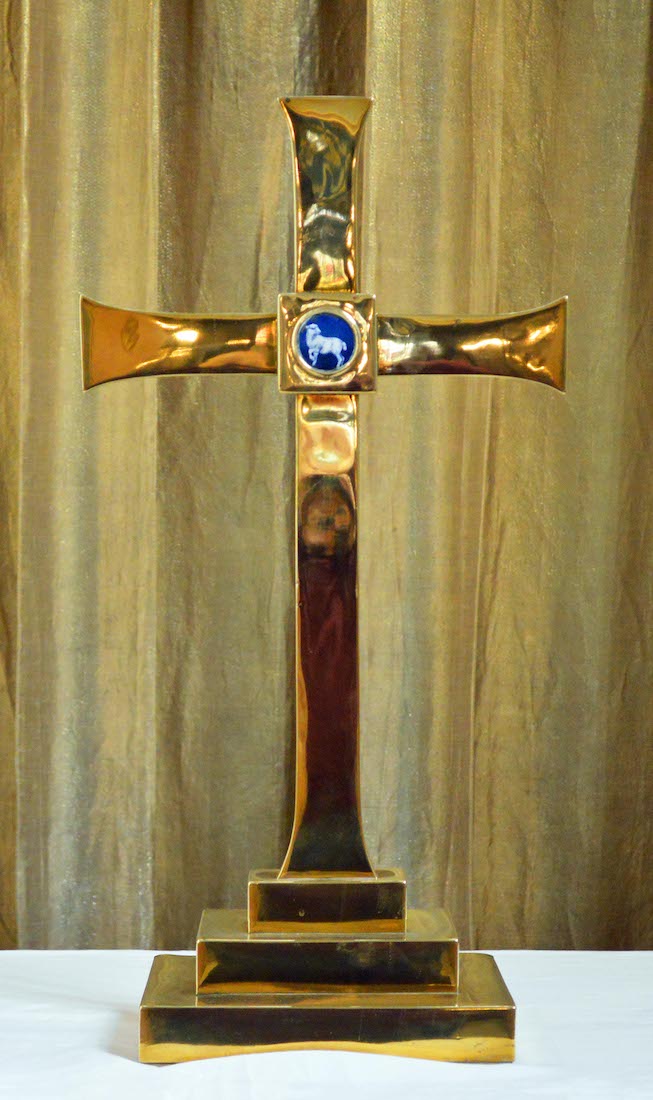
CONCLUSION
I hope you have enjoyed visiting Bradford Cathedral with me. I enjoyed my visit to the City of Bradford, and found the Cathedral very interesting.
I am happy to receive constructive comments or corrections concerning this website. The best websites are the ones which have no errors! I am grateful to my wife Margie who has proof-read these pages. I have also received input from Maggie Myers, Director of Education and Visitors at the cathedral – acknowledged with thanks.
Bradford Cathedral has its own website with link:
With one acknowledged exception, the photographs on this site are all mine, and can also be found in higher resolution at:
https://www.flickr.com/photos/paulscottinfo/sets/
I claim no credit for the text, but have drawn heavily on trusty Wikipedia, and on this Cathedral’s marvellous documentation: the booklet ‘Bradford Cathedral’ and various other pamphlets. I acknowledge these sources with grateful thanks.
Site created 06 / 2018 ; reformatted 03/ 2020
Paul Scott

